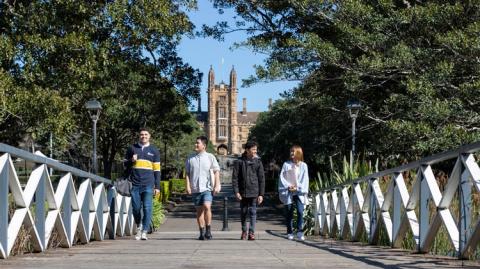Sponsored content: created in partnership with the University of Sydney.
The student experience has been revolutionised by digital technology but, fundamentally, what students require of their universities remains unchanged. Students want a sense of belonging, to feel supported and to be in control of their futures. And ultimately, they want a job after graduating.
“All of it goes back to employability,” says Susanna Scarparo, pro vice-chancellor of student life at the University of Sydney. “I would love to believe that all students come to university to learn and grow, but they also come because they want to get a job.”
Ranked number one in Australia for graduate employability, the University of Sydney introduces career development at the very beginning of the student journey. It is a key component of the university’s holistic approach to personal development. “We make sure that they develop as individuals, that they learn, they grow, leave as completely different people,” Scarparo says. “But at the same time, they get a job.”
The University of Sydney is the oldest university in Australia and enjoys the advantages that come with a location in one of the world’s most liveable cities. It teaches in more than 400 subject areas and comprises eight faculty and 10 campus locations. Students are afforded the freedom of interdisciplinary study and are encouraged to explore different academic pathways.
“What I love about it is that it is a comprehensive university in the sense that it offers many, many disciplines,” says Adam Bridgeman, pro vice-chancellor of education innovation at the university. “Most students are studying a liberal studies degree where they can make lots of choices with that ability to combine different disciplines.”
Scarparo says the university is undergoing a “major transformation” in how it manages its student body of more than 70,000 students. Its strategy gives students agency over their development, with digital tools supporting personalised development programmes.
“Crucial to our approach is student co-design,” Scarparo says. “We have been doing that for a year, co-designing programmes for students, with students. We are putting out calls for student life grants so that the students themselves can tell us what they would like to do – a social activity, for example – and then we support it and fund it so they develop their skills.”
The University of Sydney’s approach involves students from the moment they enrol, embedding career advice from day one and supporting them as they transition from year to year.
“Orientation doesn’t just drop students after the opening week,” Scarparo says. “It is effectively helping students through all the different stages of their journey.” Cultural safety is a core principle, with the institution placing particular emphasis on indigenous perspectives. There is a disability and inclusion action plan, and a number of initiatives to enhance well-being and develop students’ communication and language skills – a framework for pastoral care that’s fundamental to student success.
“Once you get to a university with an entry requirement, your academic capacity is not in doubt,” Scarparo says. “But if you are not going to feel safe, supported, connected and, more importantly, that you belong somewhere, you are not going to succeed. You are not going to do as well as you could.”
Bridgeman says digital tools bring many benefits; delivering online teaching has broken down barriers between faculty and student. But he believes the university’s on-campus activities – with more than 250 clubs and societies for students to join – will remain key to sustaining the university’s sense of community and identity.
“I think that’s where we see our future, as an on-campus, experiential university, with excellent blended experiences,” Bridgeman says.
about the University of Sydney.

Comments